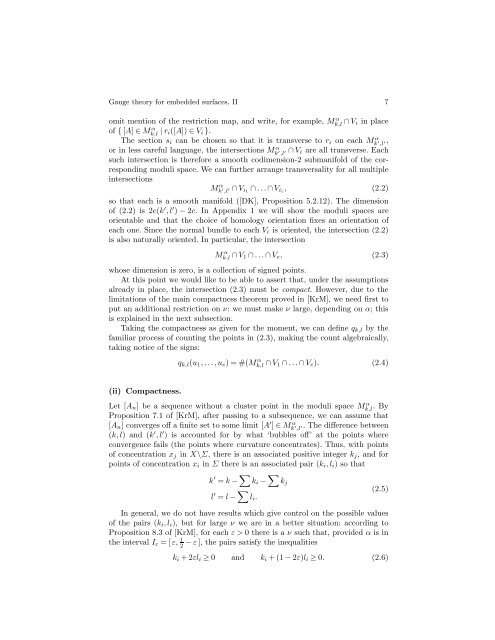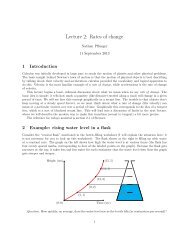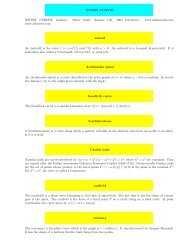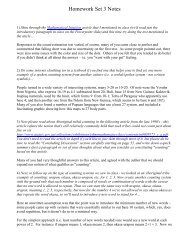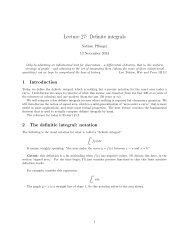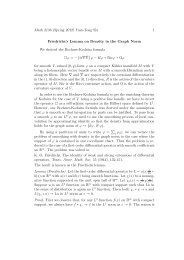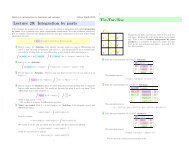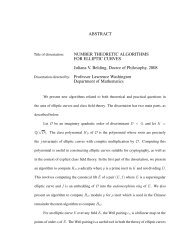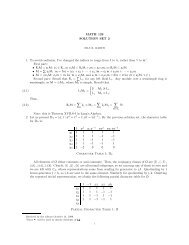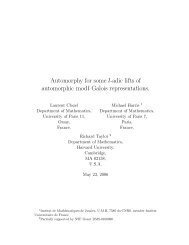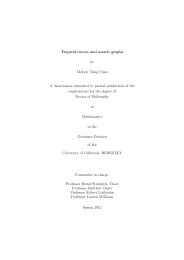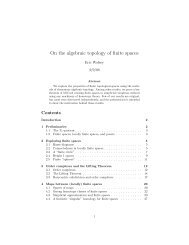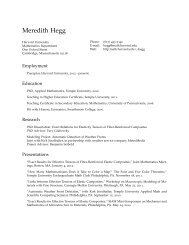Gauge theory for embedded surfaces, II
Gauge theory for embedded surfaces, II
Gauge theory for embedded surfaces, II
You also want an ePaper? Increase the reach of your titles
YUMPU automatically turns print PDFs into web optimized ePapers that Google loves.
<strong>Gauge</strong> <strong>theory</strong> <strong>for</strong> <strong>embedded</strong> <strong>surfaces</strong>, <strong>II</strong> 7<br />
omit mention of the restriction map, and write, <strong>for</strong> example, M α k,l ∩ Vi in place<br />
of { [A] ∈ M α k,l | ri([A]) ∈ Vi }.<br />
The section si can be chosen so that it is transverse to ri on each M α k ′ ,l ′,<br />
or in less careful language, the intersections M α k ′ ,l ′ ∩ Vi are all transverse. Each<br />
such intersection is there<strong>for</strong>e a smooth codimension-2 submanifold of the corresponding<br />
moduli space. We can further arrange transversality <strong>for</strong> all multiple<br />
intersections<br />
M α k ′ ,l ′ ∩ Vi1 ∩ ...∩Vic, (2.2)<br />
so that each is a smooth manifold ([DK], Proposition 5.2.12). The dimension<br />
of (2.2) is 2e(k ′ ,l ′ )−2c. In Appendix 1 we will show the moduli spaces are<br />
orientable and that the choice of homology orientation fixes an orientation of<br />
each one. Since the normal bundle to each Vi is oriented, the intersection (2.2)<br />
is also naturally oriented. In particular, the intersection<br />
M α k,l ∩ V1 ∩ ...∩Ve, (2.3)<br />
whose dimension is zero, is a collection of signed points.<br />
At this point we would like to be able to assert that, under the assumptions<br />
already in place, the intersection (2.3) must be compact. However, due to the<br />
limitations of the main compactness theorem proved in [KrM], we need first to<br />
put an additional restriction on ν: wemustmakeνlarge, depending on α; this<br />
is explained in the next subsection.<br />
Taking the compactness as given <strong>for</strong> the moment, we can define qk,l by the<br />
familiar process of counting the points in (2.3), making the count algebraically,<br />
taking notice of the signs:<br />
(ii) Compactness.<br />
qk,l(u1,...,ue)=#(M α k,l ∩ V1 ∩ ...∩Ve). (2.4)<br />
Let [An] be a sequence without a cluster point in the moduli space M α k,l .By<br />
Proposition 7.1 of [KrM], after passing to a subsequence, we can assume that<br />
[An] converges off a finite set to some limit [A ′ ] ∈ M α k ′ ,l ′. The difference between<br />
(k,l) and(k ′ ,l ′ ) is accounted <strong>for</strong> by what ‘bubbles off’ at the points where<br />
convergence fails (the points where curvature concentrates). Thus, with points<br />
of concentration xj in X\Σ, there is an associated positive integer kj, and<strong>for</strong><br />
points of concentration xi in Σ there is an associated pair (ki,li)sothat<br />
k ′ =k− ki− kj<br />
l ′ =l− li.<br />
(2.5)<br />
In general, we do not have results which give control on the possible values<br />
of the pairs (ki,li), but <strong>for</strong> large ν we are in a better situation: according to<br />
Proposition 8.3 of [KrM], <strong>for</strong> each ε>0 there is a ν such that, provided α is in<br />
− ε ], the pairs satisfy the inequalities<br />
the interval Iε =[ε, 1<br />
2<br />
ki +2εli ≥ 0 and ki+(1−2ε)li≥0. (2.6)


